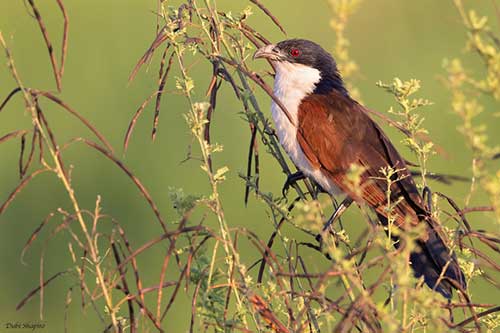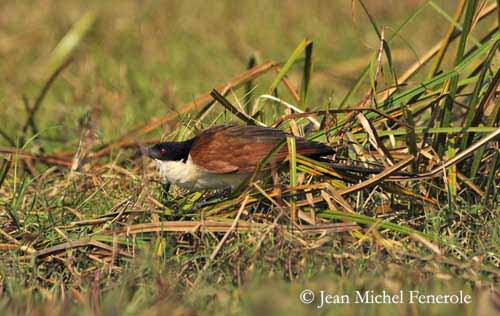

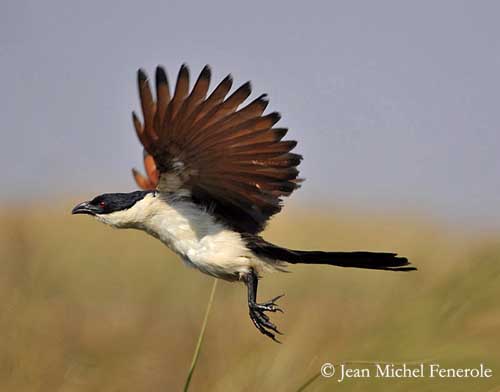
Fr: Coucal des papyrus
Ang: Coppery-tailed Coucal
All: Kupferschwanzkuckuck
Esp: Cucal Colicobrizo
Ita: Cucal codarame
Nd: Koperstaartspoorkoekoek
Sd: sumpsporrgök
Photographers:
Jean Michel Fenerole
Photos d’Oiseaux du monde
Dubi Shapiro
Dubi Shapiro Photo Galleries
Text by Nicole Bouglouan
Sources:
HANDBOOK OF THE BIRDS OF THE WORLD vol 4 by Josep del Hoyo-Andrew Elliott-Jordi Sargatal - Lynx Edicions - ISBN: 8487334229
BIRDS OF AFRICA SOUTH OF THE SAHARA by Ian Sinclair and Peter Ryan - Princeton University Press Princeton and Oxford - ISBN: 0691118159
L’ENCYCLOPEDIE MONDIALE DES OISEAUX - Dr Christopher M. Perrins - BORDAS - ISBN: 2040185607
Wikipedia, the free encyclopaedia
Coppery-tailed Coucal
Centropus cupreicaudus
Cuculiformes Order – Cuculidae Family
INTRODUCTION:
The Coppery-tailed Coucal is endemic to SC Africa where it frequents dense waterside vegetation and occasionally adjacent woodlands. Two subspecies share the range.
It feeds on amphibians, fish, small birds, reptiles and rodents, and may also take invertebrates while foraging on land.
This species is believed to be monogamous, as most of nesting cuckoos. The nest is a domed structure built low down in wet vegetation including papyrus, giving the bird its French name. Both adults share the nesting duties.
The Coppery-tailed Coucal is described as locally common, and currently, the species is not globally threatened.
DESCRIPTION OF THE BIRD:
Biometrics:
Length: 42-50 cm
Weight: M: 272 g – F: 300 g
The Coppery-tailed Coucal is a large Cuculidae with violet-glossed black upperparts from forehead to mantle, whereas back and wings are reddish-brown. The uppertail-coverts are finely barred. The rectrices are blackish brown with coppery gloss, giving the bird its English name.
The underparts are creamy-white from chin to undertail-coverts.
The strong, downcurved bill is blackish. The eyes are red. Legs and feet are black.
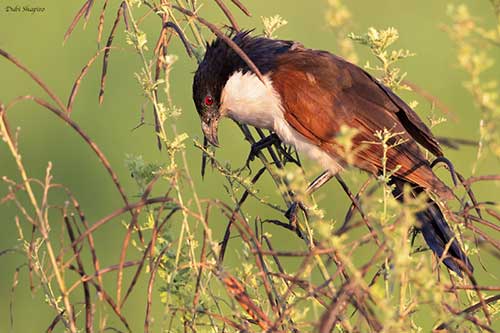
The female has similar appearance, but she is slightly larger.
The juvenile has less glossed plumage. We can see shaft-streaks on the head. There is sometimes a buff tinge on the breast and the tail is barred.
SUBSPECIES AND RANGE:
The Coppery-tailed Coucal has two subspecies.
The nominate race C.c. cupreicaudus (described above) is found in SC Africa, in C and E Angola, through S DR of the Congo, and Zambia, Botswana (Okavango River and Caprivi Strip), E part Victoria Falls in Zimbabwe, and N through C and N Malawi and SW Tanzania.
C.c. songweensis is found in S Tanzania and N Malawi.
This race is smaller and darker than nominate.
HABITAT:
The Coppery-tailed Coucal is generally found in dense waterside vegetation and usually frequents swamps, inundated flood plains, marshlands, thick reedbeds and adjacent bush and woodlands.
The species occurs from 1,100 metres in Malawi and 1,250 metres in Angola, to 1,670 metres of elevation in Zambia.
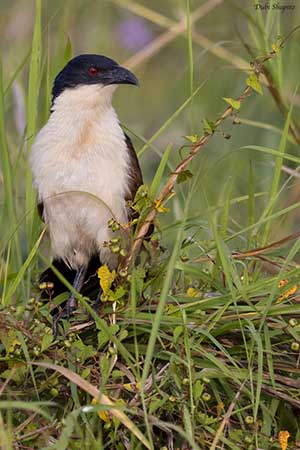
CALLS AND SONGS: SOUNDS BY XENO-CANTO
The Coppery-tailed Coucal gives deep, loud, resonant series of “doo” notes.
Among Centropus species, this one has the lowest-pitched voice.
The pairs often duet, giving calls at slightly different pitches.
The begging chicks give continuous “chuck” calls.
BEHAVIOUR IN THE WILD:
The Coppery-tailed Coucal generally forages on the ground.
It feeds on small reptiles including lizards, geckos and bush snakes. It gives a fatal blow on the head of poisonous snakes, killing them instantly. But in some cases, the bird itself has been killed by a snake while hunting.
The small birds are attacked in flight. The coucal breaks their necks with its sharp claws. But it also kills birds in their nests and on the ground, before to eat their eggs.
The Coppery-tailed Coucal is also a scavenger, but it kills small mammals, mice and various other rodents. Then, it tears up the flesh with its strong bill.
Invertebrates such as butterflies, bees, wasps, locusts and ants are hawked in the air before to be killed and eaten.
The Coppery-tailed Coucal is probably monogamous and territorial year-round.
The courtship displays are poorly known. Several species are known for spreading and raising the tail in sexual displays. The male may also offer some food to the female, prior to copulation. She may keep the food in the bill while mating.
They build a domed nest, often built by the male. It is placed in dense tangles of reed or grass, near or sometimes over water.
The Coppery-tailed Coucal is resident and usually sedentary. Some movements are reported when the habitat is destroyed by fires or grazing.
When it is flying, the distinct dark brown trailing edge is conspicuous. This species flies by alternating flapping and gliding.
REPRODUCTION OF THIS SPECIES:
The breeding season takes place from January to March, but it may vary slightly depending on the range.
The domed nest is mainly built by the male, with material found within 100 metres around the nest-site. The nest is made with reeds, twigs and grasses, and the interior is lined with softer leaves. There is a side entrance with sometimes a low runway, or flattened grasses leading to it.
The nest is usually placed among dense waterside vegetation, or in tangled grasses and reeds, near or sometimes over the water.
The female lays 2-4 white eggs at one day intervals. The incubation is probably performed by the male alone. However, the chicks are fed by both parents, mainly with locusts and frogs. The young drink regurgitated water by adults.
They leave the nest about 17 days after hatching, but the post-fledging care may last up to 40 days after leaving the nest.
PROTECTION / THREATS / STATUS:
The Coppery-tailed Coucal may be attacked at nest by Monitor lizards (genus Varanus) and Water Mongoose (Atilax paludinosus).
The species is usually sparsely distributed, but it is described as locally common, especially in marshes, along streams and rivers.
The size of the population is unknown, but it is suspected to be stable.
This species is not globally threatened, and the Coppery-tailed Coucal is currently evaluated as least Concern.
